As New Zealand's leading environmental science institute, NIWA's research touches the breadth of New Zealand, Antarctica, the Pacific, and beyond.
From the lowest depths to the highest reaches, our more than 700 staff work in the most beautiful environments on Earth. The urge to capture the moment is often irresistible, so each year we celebrate our staff's best snaps in the NIWA photography competition.
The stories behind the photos:
Jewel anemones spawning by Irene Middleton, marine ecologist

Diver Crispin Middleton observes the annual Jewel anemone spawning event in the Bay of Islands.
This image of principal technician Crispin Middleton was captured by his wife Irene - who also works at NIWA - on the Canterbury Wreck in the Bay of Islands, at about 25m depth.
It shows a female jewel anemone releasing eggs during a mass spawning event, which happens once a year just after the full moon in the middle of winter.
"The spectacle is always super exciting and is so short lived, so the dives and photography are a bit frantic," said Irene.
"I planned this shot a whole year ahead of time, so with lots of hand signals and head shaking I managed to line up Crispin perfectly as he watched the spawning anemone. I didn't get chance to check the shot until I was back on land, so I was really proud of the outcome. The colours are beautiful and the fact that he is looking right at it makes it eye catching," said Irene.
River flow gauging by Adrian Aarsen, environmental monitoring technician
Environmental monitoring technician Adrian Aarsen mixes modern and primitive tools to measure flow rates in Spey River, Fiordland. NIWA monitors rivers and streams across New Zealand to aid with things such as conservation and flood management. Here, an acoustic doppler instrument is measuring discharge levels of the Spey River in Fiordland during a period of low flow. Because the water was so low and slow flowing, technician Adrian Aarsen wasn't able to use the boat's remote controls. Instead, he goes back to basics by guiding it with a manuka branch. "I took this shot with my phone when there was a little break in the rain. It really highlights Fiordland's classic colours and weather. I felt lucky to be working in such a cool place, especially because Fiordland looks best when it's raining," said Adrian.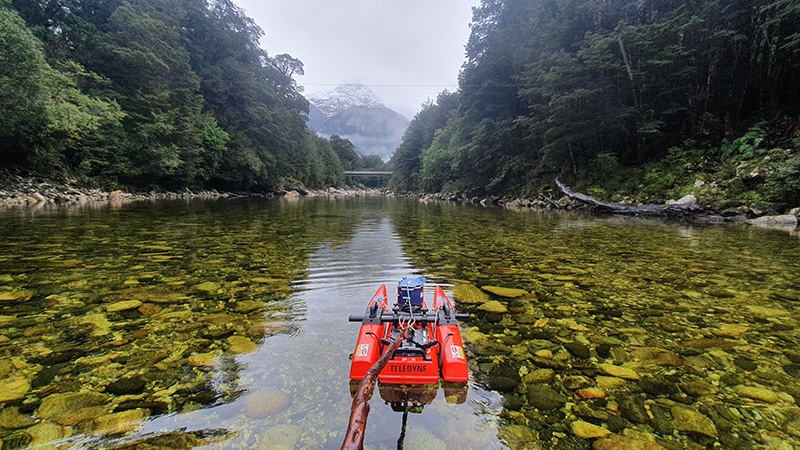
Don't drop the screwdriver by Alec Dempster, environmental monitoring technician
Replacing terminals at NIWA's Mahanga Snow and Ice Weather Station. NIWA has a network of high elevation weather stations known as the Snow and Ice Network. These measure snowfall, snow storage, snow melt, and alpine climate. Here, environmental technician Jeremy Rutherford re-connects solar radiation sensor wires on the Mahanga Range station, approximately 6km north of Lake Rotomairewhenua/Blue Lake. This picture was taken by his colleague, fellow technician Alec Dempster, who leant back as far as his tethers would allow while using a wide-angle lens to capture the snow-covered peaks in the background. "Working at these sites is always a mixture of excitement and extreme focus, but there are lots of little moments to sit back and appreciate the view. I love that the contrast between the snow and the bush line shows you just how high up we are. I like this image because it reveals the true nature of working in environments like this - it's picturesque, cold and adrenaline-fuelled!" said Alec.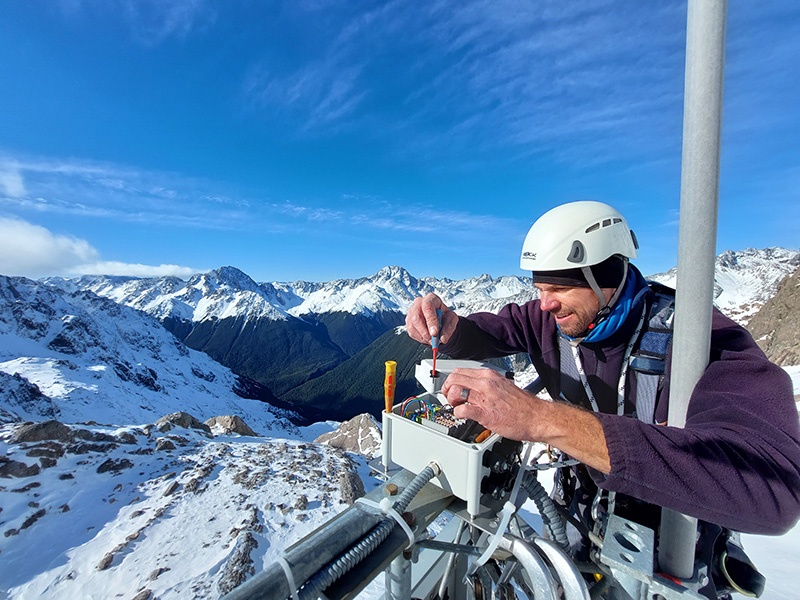
Fur seal by Mia Blyth, communications and marketing assistant
A fur seal wakes up from an afternoon nap at Allans Beach, Dunedin. A yawn or growl? Mia's photo was taken last November at Allans Beach in Dunedin - home to the seals. Mia almost walked into the animal, which was camouflaged amongst the seaweed. While it may look like the seal is giving us a vicious growl, it was in fact waking up from its afternoon nap. "I liked the way the animal slept, oblivious to the many inquisitive people that walked past. I was able to take the shot using my zoom lens to keep a safe distance," said Mia.
Shark vertebra scan by Caoimhghin Ó Maolagáin, senior fisheries technician
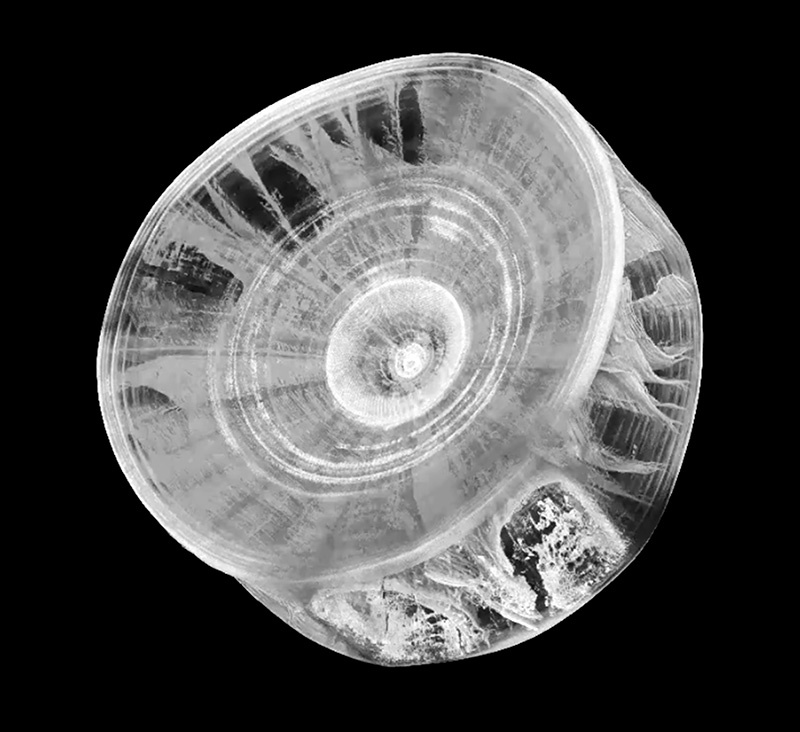
Annual age bands in an Ururoa white shark vertebra.
How old are white sharks (e hia ngā tau o ngā Ururoa)?
Caoimhghin Ó Maolagáin was tasked with this question by NIWA shark scientist Dr Brit Finucci. Caoimhghin scanned a shark vertebra with a microCT machine, which is like the CT or MRI machines that doctors use to diagnose human illness. Using advanced computers he generated this digital image, which shows annual banding patterns or rings within the vertebra, much the same as tree-ring ageing.
"For endangered species that exist in complex and threatened ecosystems, knowing how fast they grow, and the time taken to reach sexual maturity are critical factors that underly their conservation," said Caoimhghin.
Silver damsels by Mary de Winton, freshwater ecologist
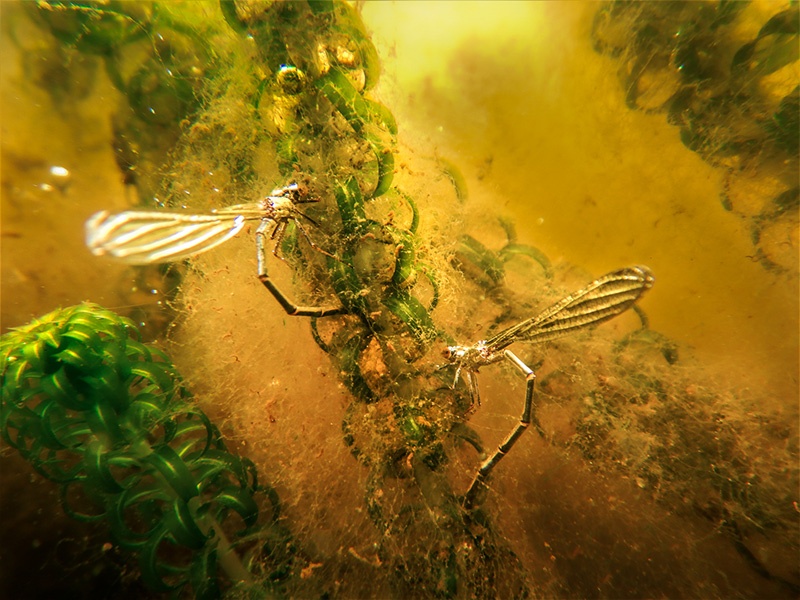
Damselflies submerge to lay their eggs in Lake Mangawhio, Taranaki.
Mary took this picture when she was part of a diving team surveying submerged vegetation in remote Lake Mangawhio for Taranaki Regional Council.
"I was in the shallows taking photos of the alien aquatic weed Lagarosiphon major when I saw these glittery insects laying their eggs on the plant's stems, about 40cm deep. They appear silver because of tiny bubbles trapped on their wings and bodies but they are actually red in colour when not submerged in water," said Mary.
Crab selfie by Chris Woods, marine ecologist

A purple rock crab (Leptograpsus variegatus) strikes a pose on the shores of Waihau Bay, East Cape.
Patience and an expert eye allowed marine ecologist Chris Woods to capture this cute crab. Known as the purple rock crab, these elusive creatures live in upper intertidal rocky zones and are often spotted on exposed rocks, before scuttling away to safety when they detect a potential predator.
"I took this image whilst on my first post-COVID campervan trip. Ferreting around for local biota and non-indigenous marine species is part of my normal duty at NIWA, but I enjoy doing it in my spare time too. Crabs have an amazing morphology in the way their exoskeleton has evolved to different ecosystems and environments. I love the colours of this species and find crab 'faces' fascinating," said Chris.
Castlepoint sunrise by Gregor Macara, climate scientist

A seagull in the morning sun at Castlepoint, Wairarapa.
Winner of this year's People's Choice Award, Gregor's photo was taken early in the morning during a camping trip at Castlepoint.
"I was woken by heavy winds hammering my tent, so got up to watch the sunrise and saw this seagull wandering in front of me. I decided to wait until it crossed the reflective area before taking the shot," said Gregor.
Storm wave by Rob Murdoch, general manager - science/deputy chief executive
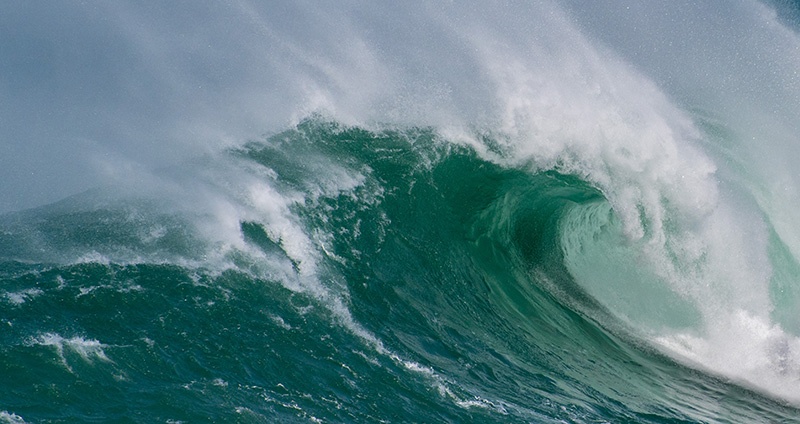
Large waves break near the airport in Lyall Bay, Wellington.
Lyall Bay is Wellington's most popular surf beach. This dramatic photo was taken there last October during massive swells, which reached the south coast of Wellington following a storm event south of New Zealand.
"Getting this shot was not for the faint hearted, and I witnessed a fellow photographer with his camera gear unexpectedly drenched knee-deep in seawater! The waves tossed debris onto the local roads and eroded sand from the beach. This photo captures the impressive and somewhat frightening power of the waves. Together with rising sea levels, it's poignant reminder of the increasing risks we face from extreme weather events as a result of climate change," said Rob.
Flooded jetty by Jennifer Beaumont, marine ecologist

A flooded Lake Rotoiti after heavy rains in Nelson.
The end of Lake Rotoiti's jetty is a popular photography spot for visitors to the Nelson Lakes. But very occasionally, it disappears entirely.
"After a big storm event in the Nelson Lakes National Park, the water in Lake Rotoiti was so high that the boat ramp and signage were flooded. It was a rare opportunity to capture this scene in a different way. I got this image once the clouds and fog cleared to reveal fresh snow on the mountains, which were reflected beautifully in the lake," said Jennifer.
Scallop diving by Crispin Middleton, principal technician - marine ecology

A diver reaches out for a scallop in Whangarei Harbour, Northland.
NIWA conducts extensive yearly surveys to monitor the health of scallops, helping with the management of sustainable scallop fishing.
Principal technician Crispin Middleton often undertakes these surveys with camera in hand, capturing shots like this to give people a glimpse of life on the ocean floor.
Ice drill setup by Natalie Robinson, marine physicist

Preparing to sample delicate platelet ice in Antarctica.
Platelet ice is a unique and fragile ecosystem that is little studied. It is a several-metre thick space where solid ice meets liquid water, and forms a dense, protective maze for algae and bacteria - the organisms that underpin the entire food chain.
Here, Natalie Robinson takes a moment to document her team assembling a coring tube in Antarctica, in preparation to collect these delicate layers of nutrient-rich ice.
Salvin's albatross by Rikki Taylor, fisheries technician

A Salvin's Albatross glides off the coast of Timaru on the Chatham Rise.
This photo-of-a-lifetime was taken by fisheries technician Rikki Taylor just after sunrise while on a survey of the Chatham Rise.
"I have been trying to get this shot for years. This time, the stars aligned - the bird's flight speed was perfectly matched with the wind and boat speed, meaning I was finally able to capture this stunning creature soaring over the ocean. I love the blurred background, crisp lines, and in-focus feathers - I'm stoked with it," said Rikki.






